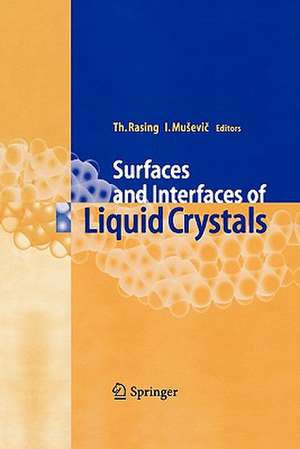Surfaces and Interfaces of Liquid Crystals
Editat de Theo Rasing, Igor Musevicen Limba Engleză Paperback – 29 noi 2010
This book addresses the microscopic interaction between a macromolecule (liquid crystal, polymer) and a wall, using state of the art surface and interface-sensitive experimental techniques, such as Atomic Force Microscopy (AFM), Scanning Tunneling Microscopy (STM), Linear and Nonlinear Optical Microscopy and (Dynamic) Light Scattering (DLS). These experimental techniques were complemented with computer simulations and supra molecular chemistry methods to develop controllable polymeric surfaces.
| Toate formatele și edițiile | Preț | Express |
|---|---|---|
| Paperback (1) | 945.30 lei 6-8 săpt. | |
| Springer Berlin, Heidelberg – 29 noi 2010 | 945.30 lei 6-8 săpt. | |
| Hardback (1) | 951.47 lei 6-8 săpt. | |
| Springer Berlin, Heidelberg – 10 aug 2004 | 951.47 lei 6-8 săpt. |
Preț: 945.30 lei
Preț vechi: 1152.81 lei
-18% Nou
Puncte Express: 1418
Preț estimativ în valută:
180.89€ • 189.24$ • 150.26£
180.89€ • 189.24$ • 150.26£
Carte tipărită la comandă
Livrare economică 03-17 aprilie
Preluare comenzi: 021 569.72.76
Specificații
ISBN-13: 9783642058684
ISBN-10: 364205868X
Pagini: 312
Ilustrații: XIII, 298 p.
Dimensiuni: 155 x 235 x 16 mm
Greutate: 0.44 kg
Ediția:Softcover reprint of hardcover 1st ed. 2004
Editura: Springer Berlin, Heidelberg
Colecția Springer
Locul publicării:Berlin, Heidelberg, Germany
ISBN-10: 364205868X
Pagini: 312
Ilustrații: XIII, 298 p.
Dimensiuni: 155 x 235 x 16 mm
Greutate: 0.44 kg
Ediția:Softcover reprint of hardcover 1st ed. 2004
Editura: Springer Berlin, Heidelberg
Colecția Springer
Locul publicării:Berlin, Heidelberg, Germany
Public țintă
ResearchDescriere
Igor Musevic, Cindy Nieuwkerk and Theo Rasing Since the pioneering work on surface-induced alignment of liquid crystals, performed by Lehmann [1], Grandjean [2], Mauguin [3], Chatelain [4], and others [5], scientist have been looking for the answer to the question: why do certain surfaces align liquid crystals and others not'? The answer to this question has become even more important with the advent of modern liquid crystal display technologies, that are based on re liable and technologically controllable surface alignment of liquid crystals, used in a variety of electrooptic devices, such as liquid crystal displays, light modulators, optical shutters, switches, holographic systems, etc. During the last decade, the progress in the technology of liquid crystal devices, as well as the discovery of a variety of novel liquid crystalline phases have triggered a considerable and intense scientific interest in the microscopic origin of surface alignment. Fortunately, this renewed scientific and techno logical interest was accompanied by the advent of modern, surface sensitive experimental techniques, that have been successfully used in the study of liquid crystal interfaces. Whereas a decade ago the mechanisms of surface alignment were "poorly understood", nowadays we can claim that we do un derstand most of the "mysteries" of the surface alignment of liquid crystals.
Cuprins
Prologue.- 1 Introduction.- 2 Surface-Induced Order Detected by Deuteron Nuclear Magnetic Resonance.- 3 Interfacial and Surface Forces in Nematics and Smectics.- 4 Linear Optics of Liquid Crystal Interfaces.- 5 Solid-Liquid Crystal Interfaces Probed by Optical Second-Harmonic Generation.- 6 Liquid Crystal Alignment on Surfaces with Orientational Molecular Order: A Microscopic Model Derived from Soft X-ray Absorption Spectroscopy.- 7 Scanning Probe Microscopy Studies of Liquid Crystal Interfaces.- 8 Introduction to Micro- and Macroscopic Descriptions of Nematic Liquid Crystalline Films: Structural and Fluctuation Forces.- 9 Applications.- Epilogue.
Textul de pe ultima copertă
This overview of the state of the art of our understanding of the liquid crystal-surface interactions on a molecular level describes recent research into the surface and interface properties of the substrate-liquid crystal interface. These properties play an essential role in the operation of liquid crystal displays (LCDs) and other LC devices, and every LC electro-optic device is based on the controllable anchoring of LC molecules on a (polymer coated) solid. The microscopic interaction between a macromolecule (liquid crystal, polymer) and a wall is still poorly understood. This book reports on the results of collaboration between several European Laboratories to study the liquid crystal interfaces with novel, surface and interface-sensitive experimental techniques, such as Atomic Force Microscopy (AFM), Scanning Tunneling Microscopy (STM), Linear and Nonlinear Optical Microscopy and (Dynamic) Light Scattering (DLS). These experimental techniques were complemented with computer simulations and supra molecular chemistry methods to develop controllable polymeric surfaces.
Caracteristici
Up-to-date overview
Accumulated knowledge of physicists and engineers on LCD
Accumulated knowledge of physicists and engineers on LCD








